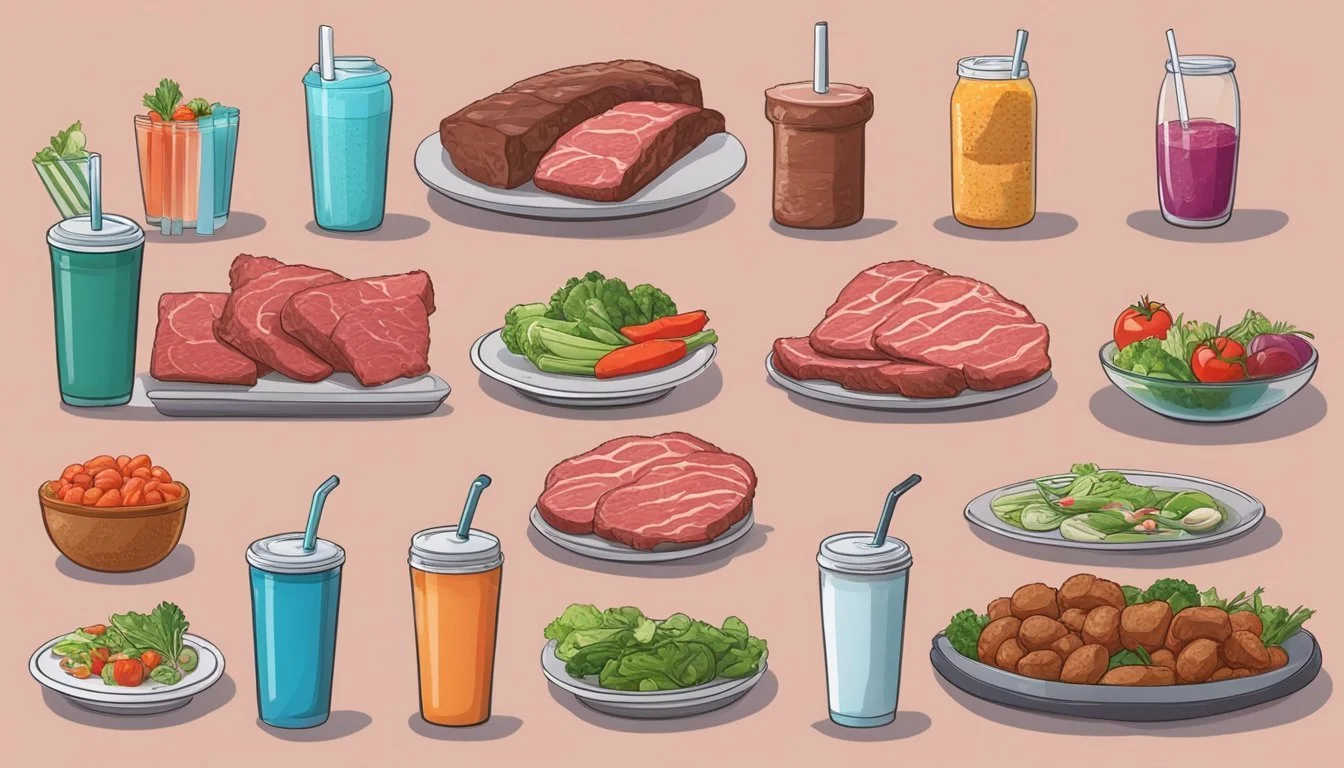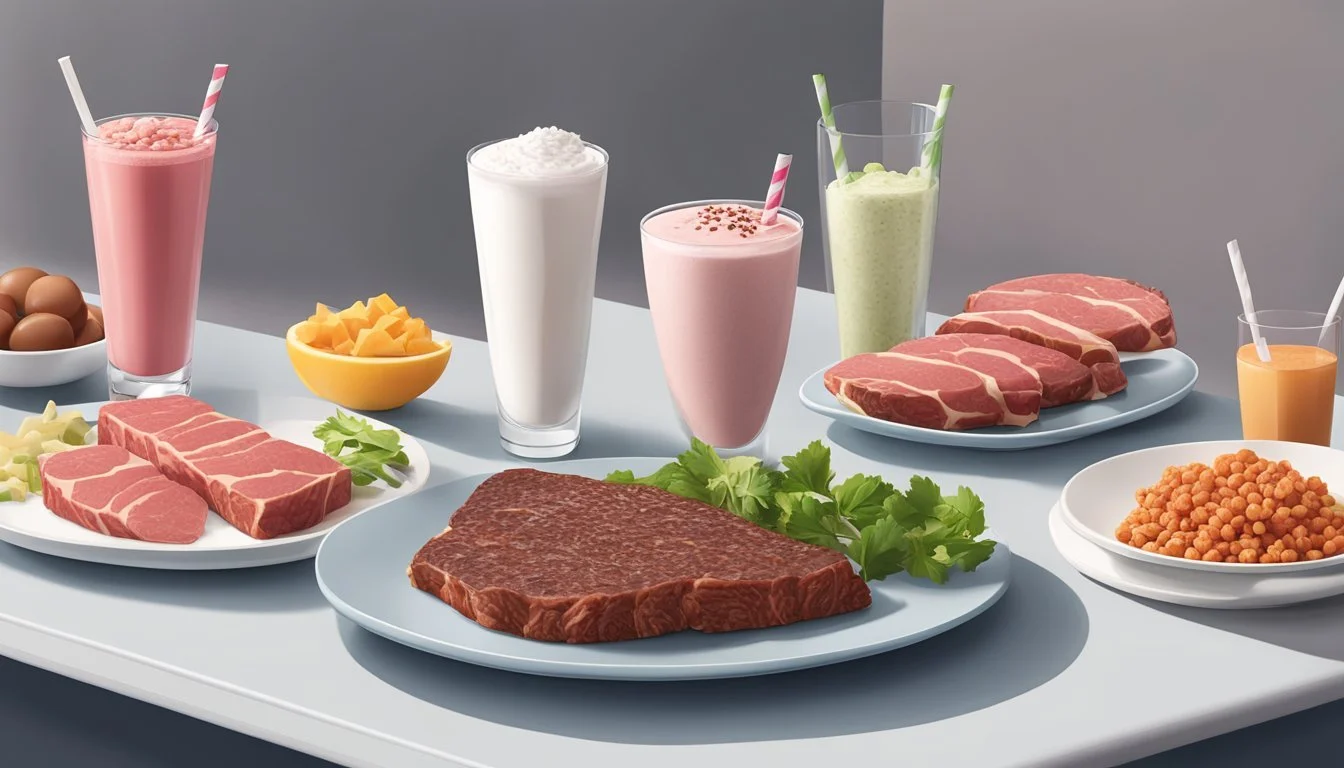Carnivore Diet vs. The SlimFast Diet
Analyzing Ease and Meal Structure
The Carnivore Diet and the SlimFast Diet represent two very different approaches to weight management and health, each with a distinct set of guidelines and principles. On one hand, the Carnivore Diet is centered on consuming exclusively animal products, including meat, fish, and eggs. Proponents of this diet suggest that it may provide all the necessary nutrients, focusing on high protein and fat intake while entirely excluding carbohydrates.
On the other hand, the SlimFast Diet is a time-tested weight loss program that emphasizes convenience through its meal replacement products, such as shakes and bars. This diet aims for short-term weight loss and is ranked for its efficacy over brief periods. However, it faces criticism regarding its nutritional content and sustainability over the long term. The convenience of SlimFast lies in its pre-packaged meals, which contrast with the Carnivore Diet's requirement for fresh food preparations.
When evaluating Carnivore Diet against the SlimFast Diet, it's crucial to consider individual lifestyle, dietary preferences, and health goals. Both diets cater to different needs, with the Carnivore Diet appealing to those seeking a simple, whole-food-based eating pattern, and the SlimFast Diet attracting individuals looking for a structured and convenient weight loss regimen.
Overview of Carnivore and SlimFast Diets
The Carnivore and SlimFast diets are dietary plans with starkly different approaches to weight loss and nutrition. One emphasizes animal products exclusively, while the other incorporates meal replacements alongside conventional food.
Philosophy and Fundamentals
The Carnivore diet is based on the premise that human beings should eat exclusively animal products, as this is argued to be more in line with certain ancestral dietary patterns. Proponents believe that eliminating plant-based foods can lead to improvements in health and well-being. Protein and fat are the primary macronutrients consumed, with little to no carbohydrate intake.
In contrast, the SlimFast Diet is aimed at weight loss through calorie restriction, portion control, and convenience. This diet includes meal replacement shakes, bars, and other packaged processed foods designed to substitute two meals a day, supplemented by sensible dinners and snacks. It emphasizes control over calorie intake and offers a variety of nutrients, including carbohydrates and a smaller proportion of protein and fat.
Typical Foods Consumed
A person on the Carnivore diet consumes:
Meats: includes red meat, poultry, pork, and organ meats.
Fish: a source of protein and omega-3 fatty acids.
Dairy: for some, includes cheese and butter.
Eggs: often included for their high-protein content.
No vegetables, fruits, grains, nuts, or any plant-based foods are consumed on a strict carnivore diet, negating intake of fiber.
Meanwhile, someone following the SlimFast Diet might consume:
Meal Replacements: shakes, bars, and other SlimFast products.
Balanced Meal: often recommended for dinner includes lean protein, vegetables, and grains for a well-rounded intake of macronutrients, including fiber.
Snacks: includes fruits, nuts, and low-calorie options within the program's structure.
Diet Structure and Daily Routine
The routine on the Carnivore diet is straightforward: one eats only animal products throughout the day. There are no specific meal times or calorie counting, and people often eat to satiety.
The SlimFast Diet structure involves:
Breakfast and Lunch: replaced by SlimFast shakes or bars.
Dinner: typically consists of a 500-600 calorie meal with a focus on lean protein, vegetables, and limited carbohydrates.
Snacks: SlimFast 100-calorie snacks or other approved options, between meals.
Nutritional Profiles and Health Impacts
Analyzing the carnivore and SlimFast diets reveals stark differences in nutritional profiles and health impacts, with each diet serving unique macronutrient distributions and potential effects on metabolism, as well as varying risks and benefits.
Macronutrient Distribution
The carnivore diet is characterized by a high-protein, high-fat, and almost zero-carbohydrate composition. It is an animal-based diet that excludes most, if not all, plant-derived foods. Contrastingly, the SlimFast diet often includes meal replacements rich in protein but can also contain moderate levels of carbs and fats, designed to control caloric intake.
Carnivore Diet: Predominantly saturated fats and protein, very low in carbs.
SlimFast Diet: Balanced macronutrient ratios based on replacement meals: protein, carbohydrates, and dietary fiber.
Vitamins and Minerals
The carnivore diet may lack certain vitamins, such as vitamin C and specific phytonutrients found in plants, potentially leading to deficiencies. Minerals like potassium and magnesium, often found in fruits and vegetables, may also be insufficient. On the other hand, SlimFast products are usually fortified with vitamins and minerals, including folate and essential nutrients needed for daily function.
Carnivore Diet: Potential deficiencies in vitamin C, potassium, magnesium, and fiber.
SlimFast Diet: Typically enriched with a variety of vitamins and minerals.
Effects on Metabolism
The carnivore diet's negligible carbohydrate content can induce a state akin to the ketogenic diet, promoting ketosis, where fat is burnt for energy instead of glucose. SlimFast can also be low in carbs, which may similarly affect metabolism and help manage insulin levels.
Carnivore Diet: Can lead to a metabolic state of ketosis similar to that of a strict ketogenic diet.
SlimFast Diet: Generally lower in carbs compared to a standard diet, potentially offering metabolic benefits similar to low-carb regimens.
Potential Risks and Benefits
The carnivore diet's lack of variety might pose heart disease and certain inflammation-related health risks due to high saturated fat intake. Conversely, its adherence to a low-carb, high-fat eating pattern could lead to short-term weight loss and improvements in conditions like obesity and diabetes. SlimFast provides structure and convenience, which might aid in weight management. However, reliance on processed meal replacements may not offer the same health benefits as a diet comprising whole foods.
Carnivore Diet: Risks include heart disease and micronutrient deficiencies; benefits may include weight loss and improved blood sugar control.
SlimFast Diet: Benefits include convenience and calorie control; risks may involve insufficient whole food nutrition and long-term sustainability issues.
This comparative analysis underscores the importance of a diet's nutritional content and its potential health implications. Each diet has distinct advantages and disadvantages that need consideration.
Cultural and Lifestyle Considerations
Choosing between the Carnivore Diet and the SlimFast Diet involves understanding their cultural relevance, community support, and how they integrate with an individual's personal lifestyle. Each diet presents unique challenges and considerations for social settings and daily routines.
Popularity and Community Support
The Carnivore Diet has gained popularity largely through anecdotal success stories and public figures like Jordan Peterson advocating its benefits. This all-meat diet emphasizes eating animal products only and excludes carbohydrates, thereby operating on the principle of ketosis similar to a zero-carb diet. It has a growing community online where individuals share experiences and support each other. In contrast, the SlimFast Diet has been established since the 1970s, marketed widely, and enjoys brand recognition. It provides structured meal plans with shakes and snacks and promotes a balance that may include coffee, tea, or even alcohol in moderation.
Adaptation to Personal Routines
Individuals on the Carnivore Diet must often prepare their own meals, which can be challenging for those with busy lifestyles. Registered dietitians may not frequently recommend this diet due to its restrictive nature and potential lack of essential nutrients not found in meat. Meanwhile, the SlimFast Diet offers convenience through ready-to-eat products, which can easily adapt to an on-the-go lifestyle. Both diets require consultation with a healthcare provider, particularly for individuals with specific health conditions or dietary needs.
Influence on Social and Dining Habits
Social engagements and dining out can be more complex for individuals on an all-meat diet due to limited options that fit the strict dietary guidelines. Dieters may face challenges when social settings do not cater to the consumption of only animal products, excluding other common foods like vegetables and grains. In comparison, those following the SlimFast Diet may find it easier to participate in social gatherings since one calorie-controlled meal per day is allowed, offering some flexibility. However, neither diet aligns closely with the Mediterranean diet, which is often associated with a healthy lifestyle and includes a variety of foods and regular exercise.
Weight Loss and Management
In comparing the Carnivore Diet and the SlimFast Diet, it's essential to consider how each approach facilitates weight loss, their sustainability, and their respective weight management strategies.
Mechanisms of Weight Loss
Carnivore Diet:
Creates a calorie deficit indirectly by focusing on high-protein, high-fat animal foods, which may lead to a reduction in appetite.
Might inadvertently induce a state of ketosis similar to the keto diet, which can contribute to weight loss.
SlimFast Diet:
Operates on the principle of a calorie deficit achieved through meal replacements that have a predetermined calorie count.
Includes low-calorie shakes and snacks designed to simplify calorie counting.
Sustainability and Long-Term Effects
Carnivore Diet:
Sustainability is questionable due to the exclusion of all plant foods, posing challenges for obtaining certain nutrients and adhering to the diet.
Little evidence exists on the long-term effects; potential risks include nutrient deficiencies and increased cholesterol levels.
SlimFast Diet:
Offers convenience with meal replacements, which can improve adherence in the short term.
Long-term success may depend on one’s ability to transition to a balanced diet that includes conventional food for weight management.
Comparing Weight Management Approaches
The Carnivore Diet's avoidance of carbohydrates aligns with low-carb diets, appealing to those who favor ketosis.
SlimFast emphasizes portion control and calorie reduction, with the potential to include a variety of foods in smaller quantities.
Neither diet specifically emphasizes exercise as a vital component of weight loss, although it is essential for overall health and obesity prevention.
Integration with intermittent fasting is possible with both diets; however, it may be more difficult to align meal replacements with fasting windows.
Both diets can lead to weight loss through different mechanisms, but their effects on weight management and potential for weight gain upon cessation vary. Dieters should carefully consider their ability to adhere to either eating pattern in the long term.
Practicality and Affordability
Choosing between the Carnivore Diet and the SlimFast Diet involves considering the practicality of maintaining these eating patterns and their impact on one's budget. This section examines the ease with which one can adhere to these diets, compares their costs, and discusses the accessibility of the required foods.
Ease of Adherence
The Carnivore Diet, an elimination diet focusing on zero-carb intake, offers simplicity in its approach but may pose challenges for long-term adherence due to its restrictive nature. One eats exclusively animal-based products, like meats, fish, and eggs, which eliminates the need to track carbohydrate intake or count calories. Conversely, the SlimFast Diet operates on convenience, providing pre-packaged shakes and meal replacements that simplify meal planning and are ideal for on-the-go consumption.
Cost Comparison
Carnivore Diet:
Budget range: $40 - $150 per week
Type: Primarily fresh, often unprocessed meat
SlimFast Diet:
Budget range: Comparable to regular groceries, depending on shake and meal bar consumption
Type: Pre-packaged shakes and meal replacements
When comparing expenditure, the SlimFast Diet can seem less expensive initially due to its reliance on processed meal replacements, which may offer cost savings over fresh meat. However, frequent consumption of SlimFast products might lead to similar or higher overall costs compared to budget-conscious choices on a Carnivore Diet.
Accessibility of Foods
Foods required for the Carnivore Diet are widely accessible, though options like organ meats or high-quality cuts can be more expensive and difficult to find. In contrast, SlimFast products are readily available at supermarkets, but one might be limited to the varieties and flavors offered. This accessibility supports the diet's convenience, especially for those with limited time for food preparation.
Health Conditions and Dietary Restrictions
In evaluating the Carnivore and SlimFast diets, it is essential to consider the effects they may have on individuals with existing health conditions and dietary restrictions. These can include chronic diseases, autoimmune disorders, and the need for specific dietary adjustments due to health issues.
Impact on Chronic Diseases
Chronic diseases such as diabetes and heart disease require careful dietary management. The Carnivore Diet, largely consisting of meat, may increase the risk of elevating LDL cholesterol, which is linked to heart disease. A diet high in saturated fats from animal products could potentially exacerbate this condition. On the other hand, the SlimFast Diet, typically lower in fat and calorie-controlled, may be beneficial for those managing diabetes as it promotes weight loss, which can improve blood sugar levels.
Diabetes: While SlimFast might offer portion control, the Carnivore Diet lacks in providing the necessary dietary fibers that can aid in blood sugar regulation.
Heart Disease: A high intake of red and processed meats, common in the Carnivore Diet, is associated with an increased risk of heart disease.
Autoimmune Disorders and Allergies
Those with autoimmune disorders might find the limited food variety in the Carnivore Diet either beneficial or restrictive, as it eliminates common allergens and inflammatory foods. However, the lack of plant-based nutrients and fibers could pose a risk for long-term health. The SlimFast Diet might offer more variety but could include ingredients that trigger allergies or autoimmune responses.
Autoimmune Disorders: Some believe that the simplicity of the Carnivore Diet may decrease autoimmune symptoms due to fewer food triggers.
Dietary Adjustments for Specific Conditions
For individuals with dietary needs specific to conditions like high blood pressure or colorectal cancers, adjustments are crucial. High sodium content in processed meats, often a part of carnivore eating patterns, is not ideal for those with high blood pressure. Conversely, the SlimFast Diet's processed meal replacements may also contain higher sodium levels.
High Blood Pressure: Diets should be lower in sodium and rich in fruits and vegetables, which is not aligned with the Carnivore Diet.
Colon and Colorectal Cancer: There is evidence suggesting that red and processed meats increase the risk of these conditions, implicating the Carnivore Diet could be potentially harmful in these cases.
Conclusion
When comparing the Carnivore Diet and the SlimFast Diet, individuals should consider their lifestyle, dietary preferences, and health goals. The Carnivore Diet involves exclusive consumption of animal products and is often selected by those seeking to eliminate plant-based foods, which they may find problematic. In contrast, the SlimFast Diet offers a structured, calorie-restricted plan that allows for one traditional meal alongside meal replacements.
Carnivore Diet:
Focus: Animal-based foods only.
Eating Pattern: No specific meal timing; eat when hungry.
Convenience: May be challenging due to the need for constant access to fresh meat and a possible increase in meal preparation time.
SlimFast Diet:
Focus: Controlled calorie intake with meal replacements.
Eating Pattern: One main meal plus multiple meal replacements throughout the day.
Convenience: High, with portable and quick meal replacement options.
Individuals must weigh the pros and cons based on their health needs, the sustainability of the diet, and personal food preferences. Consulting healthcare professionals before adopting any significant dietary changes is advisable, as they can provide personalized advice suited to one's health status and nutritional requirements. Both diets can offer benefits, but they also carry potential risks, emphasizing the importance of informed decision-making.








